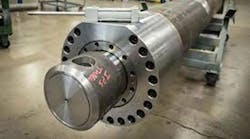A question I get asked a lot by equipment owners, is the procedure for storing spare hydraulic cylinders for an extended period. So here's what I recommend:
- Always store fully retracted.
- Store indoors in a clean, dry area.
- Smear the internal surfaces of eye/clevis bushes or bearings with grease - particularly if they're steel.
- Protect any exposed chrome on the rod. Petroleum jelly-impregnated tape such as Denso tape can be used for this purpose. Before applying, make sure the rod is fully retracted. N.B. if a product like Denso tape is applied to the rod when the rod is not fully retracted, subsequent retraction of the rod can result in damage to the rod seal.
- Plug the service ports with steel - not plastic, plugs or blanking plates.
- Consider filling the cylinder with clean hydraulic oil through its rod-end service port. Particularly if it is an expensive, large diameter or high pressure cylinder. I say "consider" because there are a few issues to understand before you do this.
If the cylinder is not filled with oil it will obviously be filled with air. If this air is not perfectly dry, then as ambient temperature decreases the air can reach due point. This results in moisture forming on the inside of the cylinder tube. This can cause spot rusting and pitting of the tube surface. And this will reduce the volumetric efficiency of the cylinder, the service life of the piston seal, and ultimately, the life of the tube itself.
Completely filling the cylinder with clean hydraulic oil prevents this from occurring, however there's a major caution with doing this. It's best illustrated by an example:
Say a cylinder is prepared for storage during the winter months. When the cylinder is filled with oil, the ambient temperature is 10 degrees Celsius. A year and a half later, during the middle of summer, the same cylinder is set down beside the machine to which it is to be installed. In the heat of the midday sun the temperature of the cylinder rises to 40 degrees Celsius. Assuming an infinitely stiff cylinder, the pressure of the oil in the cylinder resulting from the rise in temperature can be approximated by the formula:
P (bar) = 11.8 x (T2 - T1)
So the theoretical pressure of the oil in the cylinder is now: 11.8 x (40 - 10) = 354 bar or 5134 PSI! When it comes time for the unsuspecting mechanic to crack loose the blanks on the cylinder's service ports ... well let's just say that's more excitement that he signed up for.
That said, cylinders CAN be safely filled with oil for storage provided you:
- Check that the worst-case temperature rise in storage won't result in a static pressure that exceeds the cylinder's working pressure.
- Only fill the cylinder when fully retracted and ONLY through the rod-end port. This avoids potentially dangerous pressure intensification.
- Use service port plugs or blanks that are rated for the cylinder's working pressure.
- Attach appropriate warning tags to BOTH service ports.
- Provide a means to check and vent any pressure before each of the service port blanks is removed. A simple way to do this is to fit each port blank with a pressure test-point. This enables the quick attachment of a pressure gauge to check the pressure in the cylinder. And if necessary, the pressure can be safely vented into a drum using a test-gauge hose.
As you can see, this procedure is somewhat involved and so the decision to fill a hydraulic cylinder with oil is something you have to weigh up based on the value of the cylinder and how long you expect it to be in storage. But the bottom line is, not properly preparing spare hydraulic cylinders for long term storage can be a costly mistake. And to discover six other costly mistakes you want to be sure to avoid with your hydraulic equipment, get "Six Costly Mistakes Most Hydraulics Users Make... And How You Can Avoid Them!" available for FREE download here.

